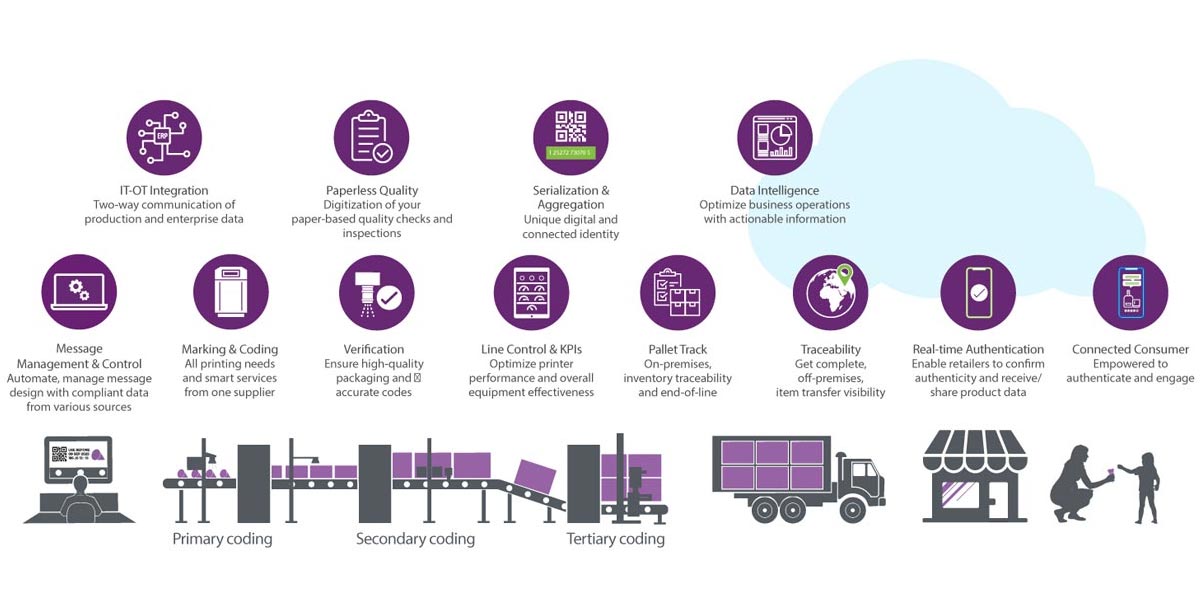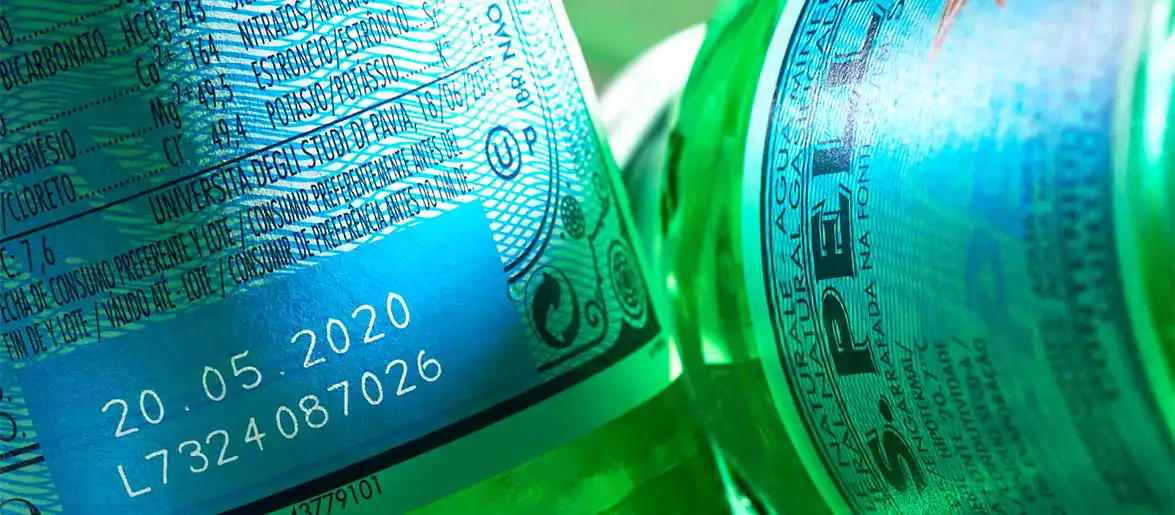Printing onto glass offers
Printing onto glass machine series for 100% readable codes that ensure product traceability with inks specially designed for food and beverage industries.

YOUR CHALLENGES
Printing onto glass, with its fragile but dense, non-porous nature, is one of the more challenging substrates to code on, but it is a popular packaging substrate precisely because of its composition. Some of the sectors it is most commonly used in include the beverage sector and cosmetics in FMCG, as well as others like pharma, construction, the automobile industry and solar power. Despite their differences, these are also some of the most demanding applications in terms of coding requirements and marking conditions.
This is due to several factors:
- An increasing need to include more information on the substrate e.g. for traceability, and to code in more complex formats, including in 2D, like QR codes.
- Requirement to code at even higher production speeds and pack rates, especially in beverage coding, with a need to maintain consistently excellent quality.
- Humid environmental conditions, e.g. for beverage coding, demanding a high level of adhesion, or indelibility, besides a need for substrate cleanliness for coding.
- Inherent fragility and, often, curved shape, makes coding challenging; plus, glass can be either clear or colored, presenting contrast challenges.
- Demand for waste reduction and increased sustainability, means reducing bottle wrapping and labels as well as glass thickness, which increases its fragility.
- Increasing demand for returnable bottles that require codes that last through consumption but are then easily removable.
Fortunately, we can help you find the ideal printing onto glass solution to meet your needs.
OUR SOLUTIONS
Markem-Imaje offers three technologies for printing onto glass, depending on your application need, continuous inkjet (CIJ), CO2 laser and UV laser. Glass is ever popular in FMCG, in part because it is infinitely reusable and can be broken down, melted and reformed without it losing its purity or quality. By far the most common printing onto glass application is for food and beverage, principally expiration dates, is perennially popular and obligated in major markets including the UE and the US. This is followed by other FMCG applications like cosmetics and perfumes made of glass, including more premium products, where there may be some design and branding elements involved. For both these applications, CIJ and CO2 laser are the optimum technologies.
Within the area of printing on bottles for FMCG, printed paper labels are often directly applied onto glass bottles, especially within the beverage sector, for their ability to carry ingredient and branding information. Due to the demand to print in humid conditions and often on curved surfaces, we offer both CIJ and CO2 laser solutions. If you are looking for plastic bottles printing page, please see our dedicated page by clicking through the link.
Increasingly, in sectors like automobile and solar energy, we are seeing increased demand to print 2D codes for traceability purposes directly onto the glass. For complex applications like these and for decorative glass applications, Markem-Imaje UV laser technology excels.
Simply leave your e-mail address in the form of this page to be contacted by one of our experts who can provide detailed information and can help you find the best solution for your printing onto glass needs.
What our customers say about our solutions
We needed clarity, precision, perfect quality and legible messages at a high output speed of up to 60,000 bottles/hour. With Markem-Imaje we found the partner we were looking for.
Raffaele Bini, Engineering Manager, Sanpellegrino.
Quick links — Jump to the right section directly!
Connected Packaging and Packaging Intelligence software
Our Packaging Intelligence solutions combine our proven coding and marking expertise with our experience to deliver complete turnkey solutions for achieving the maximum packaging line efficiency, trouble-free data management, and supply chain traceability all the way to the consumer’s hands. CoLOS® will significantly enhance your productivity and quality control while also addressing the challenges of waste and costs in an ever-changing manufacturing environment, creating a smarter business. Looking for a partner to develop your product’s digital roadmap? Markem-Imaje end-to-end solutions include leading solutions for supply chain traceability and authentication through our Systech brand and an ultimate consumer engagement experience with Blue Bite.
With more than four decades of experience in Continuous Inkjet (CIJ) innovation, Markem-Imaje has a full range of coders for printing onto glass. Our vast ink portfolio, including competitively priced MEK-free inks and reduced VOC varieties for reduced environmental impact, as well as inks for returnable bottles, makes Markem-Imaje CIJ printers the most flexible and one of the most reliable on the market today. Designed for maximum uptime, TCO and ease-of-use, our CIJ range simplifies daily activities and makes your coding process seamless.
Markem-Imaje 9330
CIJ printer designed for light to medium duty production lines, the 9330 series offers versatility, cost-effectiveness, and longevity, covering all your basic printing onto glass needs, with the capacity to code for more than 8,000 hours non-stop.
Markem-Imaje 9750
CIJ printer designed for medium to heavy-duty production lines, the 9750 is primed for digitalization and traceability with its unique 24-pin interface delivering clear, customizable, traceable black or colored codes, including 2D codes (QR and DotCodes), in a modular format which is easy-to-use.
Markem-Imaje 9750+
CIJ printer designed for large and high-speed production fleets and challenging print jobs, the 9750+ features a revolutionary, polyvalent ink circuit for both standard marking or pigmented contrast printing, giving you the highest level of
flexibility and inventory streamlining across your installed base.
Markem-Imaje 9750 Expert Series
CIJ printer designed for the most challenging and fast FMCG coding operations, the market-first 9750 Expert Series of CIJ printers has been innovated to mark tiny surfaces, deliver enhanced 2D messages, including QR codes, and only requires
one type of coder for dye or pigment prints.
CIJ Flexible Packaging Consumables
We offer a full range of proprietary inks to match your requirements for printing onto glass, including MEK-free options. Our consumables range includes fast-drying inks with a high level of resistance to water, cleaning agents and the pasteurization process, besides high-adhesion inks, ideal for beverage printing as well as industrial applications. We also offer ink primed for returnable glass made of RGB.
Our SmartLase ® CO2 and UV laser printers provide high-quality, permanent codes for your varying printing onto glass needs. With patented Intelli’Arc® scribing, paired with on-board Intelli’Cool® to lower temperatures, our lasers deliver crisp, high-contrast codes with greater uptime and reliability than others. Our lasers also meet the highest standard of safety for E-stop and interlock circuits, ISO 13849-1 / PLe 4.
SmartLase ® C150 and C350
30-watt laser printer designed for medium to high-speed intermittent or continuous lines, the SmartLase ® C150 and C350 30-watt CO2 lasers deliver permanent, crisp, clear and traceable codes on flexible packaging, at up to 150,000 products per hour.
SmartLase ® C350 BOU
Laser printer designed for tight spaces where other laser coders cannot reach, the SmartLase ® C350 BOU (Beam Orientation Unit) offers easy integration in medium to high-speed production lines with the highest quality indelible codes printed onto glass bottles and 1D and 2D codes on glass bottle labels.
View SmartLase® C350 BOUSmartLase ® C600
Laser printer designed for high-speed applications like beverage coding and for the most challenging Industry 4.0 environments. Our most advanced CO2 laser coder, the SmartLase ® C600, delivers superb code quality and more power, even with 1D and large 2D codes, at rates of up to 150,000 products per hour, according to the application.
View SmartLase® C600SmartLase ® C600 BOU
The SmartLase® C600 BOU (Beam Orientation Unit) is a fast 60-watt laser that provides permanent coding at rates of up to 150,000 products per hour even in the tightest of spaces, ideal for beverage lines. The coder can be configured with up to three elbows and four tubes that come in six standard lengths to meet most installation scenarios.
View SmartLase ® C600 BOUSmartLase® UV 500
Designed for high-density materials like glass, our SmartLase® UV500 5-watt UV laser delivers the most precise, high-quality coding with the added benefit of minimal heat transfer. Excels at static, decorative printing onto glass and for track-and-trace applications with the ability to produce tiny 2mm x 2mm scannable 2D codes ideal for car windshields, test tubes, and more.
View SmartLase® UV 5002D codes have already become an indispensable method of connecting your products to the Internet, facilitating vast amounts of product data and customization possibilities. They are also simultaneously becoming essential to comply with new regulations and standards, especially concerning traceability, including for the GS1 Digital Link, Digital Product Passport, and the US FDA’s FSMA regulations. The advantages of 2D codes for boosting brand loyalty through the supply chain are unrivaled. The possibilities for promoting sustainability efforts, packaging design efficiencies, and retail process optimization are enviable.
With the GS1 set to begin phasing out 1D barcodes in favor of 2D codes like the QR and DataMatrix from 2027, at Markem-Imaje, we have GS1 Digital Link-compliant 2D codes at the heart of our innovations from our coding hardware to software solutions supporting leading brands and retailers around the world to define and implement their connected product roadmap. Connect with us to talk to an expert or read more on our 2D solutions dedicated page!
Simply leave your e-mail address in the form to be contacted by one of our experts who can provide detailed information and can help you find the best solution for your requirements for printing onto glass.
You may also be interested in discovering more about...
Consumables and supplies
Inks and additives: find our genuine CIJ, DOD, TIJ, and Touch Dry Hot melt inks adapted to each marking need.
Software
CoLOS® industrial software solutions: find options to digitalize your packaging operations easily.
Solutions
- Find our Packaging Intelligence Solution to enhance and achieve traceability: Colos traceability solutions.
- Find industry hot topics that benefit from using 2D barcodes for connected products:
Connected and compliant 2D barcodes - Find out to optimize beverage coding at all packaging levels: Beverage solutions



